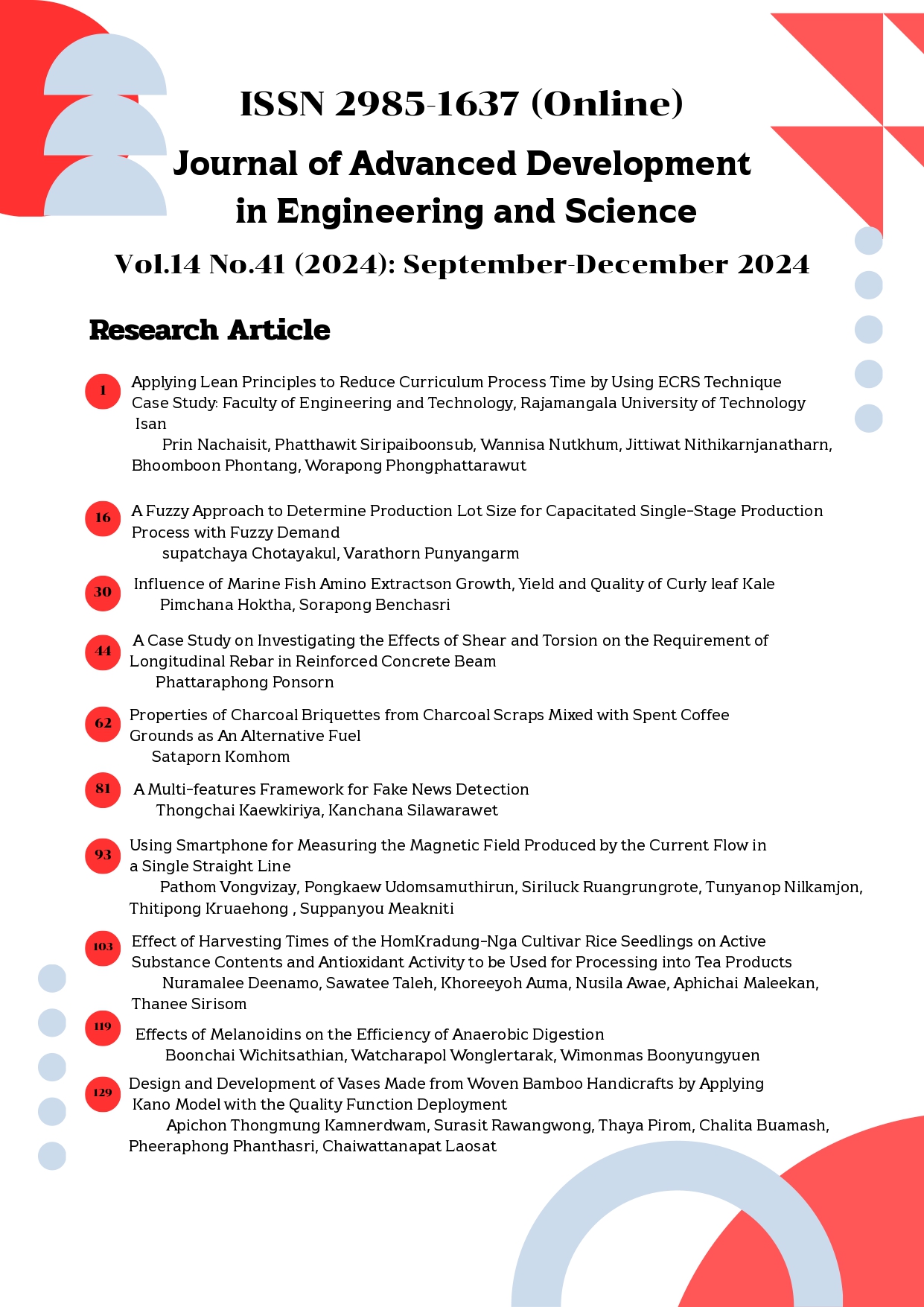การออกแบบและพัฒนาผลิตภัณฑ์แจกันจากหัตถกรรมไม้ไผ่ จักสานโดยประยุกต์ใช้แบบจำลองคาโนร่วมกับการแปลงหน้าที่ เชิงคุณภาพ
Main Article Content
บทคัดย่อ
การวิจัยนี้มีวัตถุประสงค์เพื่อประยุกต์ใช้เทคนิคแบบจำลองคาโนร่วมกับการแปลงหน้าที่เชิงคุณภาพสำหรับการออกแบบและพัฒนาผลิตภัณฑ์แจกันไม้ไผ่จักสานที่เหมาะสมกับความต้องการของลูกค้า ซึ่งงานวิจัย นี้เริ่มจากการประยุกต์ใช้การแปลงหน้าที่เชิงคุณภาพ (QFD) โดยจัดทำแบบสอบถามที่ 1 เพื่อสำรวจความต้องการของลูกค้าที่มีต่อผลิตภัณฑ์ จากนั้นได้ประยุกต์ใช้แบบจำลองคาโน (Kano Model) ในการจัดทำแบบสอบถามที่ 2 เพื่อสำรวจและวิเคราะห์หาค่าสัมประสิทธิ์ความพึงพอใจและความไม่พึงพอใจของความต้องการที่ลูกค้ามีต่อผลิตภัณฑ์ ซึ่งความต้องการของผลิตภัณฑ์ที่ผ่านเกณฑ์สามารถนำมาเป็นองค์ประกอบในการออกแบบผลิตภัณฑ์ได้ หลังจากนั้นได้ประยุกต์ใช้การแปลงหน้าที่เชิงคุณภาพอีกครั้งเพื่อวิเคราะห์ความต้องการและข้อกำหนดทางเทคนิค เป้าหมายด้านเทคนิคของผลิตภัณฑ์ ผลการวิเคราะห์พบว่าจากการพัฒนาโดยเทคนิคแบบจำลองคาโนร่วมกับเทคนิคการแปลงหน้าที่เชิงคุณภาพ ผลิตภัณฑ์แจกันไม้ไผ่จักสานมีการเปลี่ยนแปลงทางด้านรูปแบบ คุณภาพ ลวดลาย ขนาด รูปทรง และลักษณะการใช้งานซึ่งมีความสอดคล้องกับความต้องการของลูกค้าได้มากยิ่งขึ้น นอกจากนี้จากการประเมินความพึงพอใจพบว่ามีค่าคะแนนความพึงพอใจเชิงเทคนิคในด้านสวยงามทันสมัยของผลิตภัณฑ์เป็นอันดับแรก ซึ่งอยู่ในระดับดีมากและมีค่าเฉลี่ยเท่ากับ 4.53 และมีค่าคะแนนความพึงพอใจเชิงเทคนิคในด้านเป็นอัตลักษณ์ท้องถิ่นของผลิตภัณฑ์ได้เป็นอันดับสอง ซึ่งอยู่ในระดับดีมากและมีค่าเฉลี่ยเท่ากับ 4.50
Article Details

อนุญาตภายใต้เงื่อนไข Creative Commons Attribution-NonCommercial-NoDerivatives 4.0 International License.
เนื้อหาและข้อมูลในบทความที่ลงตีพิมพ์ใน Journal of Advanced Development in Engineering and Science ถือเป็นข้อคิดเห็นและความรับผิดชอบของผู้เขียนบทความโดยตรง ซึ่งกองบรรณาธิการวารสารไม่จำเป็นต้องเห็นด้วยหรือร่วมรับผิดชอบใดๆ
บทความ ข้อมูล เนื้อหา ฯลฯ ที่ได้รับการตีพิมพ์ในJournal of Advanced Development in Engineering and Science ถือเป็นลิขสิทธิ์ของ Journal of Advanced Development in Engineering and Science หากบุคคลหรือหน่วยงานใดต้องการนำทั้งหมดหรือส่วนหนึ่งส่วนใดไปเผยแพร่ต่อหรือเพื่อกระทำการใดๆ จะต้องได้รับอนุญาตเป็นลายลักษณ์อักษรจาก Journal of Advanced Development in Engineering and Scienceก่อนเท่านั้น
เอกสารอ้างอิง
Soithong, P. (2022). The home decorated product design by household bamboo wicker product structure concept. Case study of Bang Chao Cha, Pho Thong District, Ang Thong Province. Journal of Fine Arts Research and Applied Arts, 9(2), 141-159. (in Thai)
Saima, W. (2021). A study of original patterns of bamboo basketry development for decorative purposes: A case study of the elderly cooperative group in Kiu Lae Pa Pao Village, Mae Wang District, Chiang Mai. Research and Development Journal Suan Sunandha Rajabhat University, 13(2), 119-133. (in Thai)
Chainun, C., et al. (2019). Development of local wisdom product bamboo furniture, in Mae Hong Son Province. Rajabhat Chiang Mai Research Journal, 20(2), 38-52. (in Thai)
Chaudha, A., et al. (2011). Integration of Kano’s model into quality function deployment (QFD). International Journal of Advanced Manufacturing Technology, 53, 689-698.
Hashim, A. M., & Dawal, S. Z. M. (2012). Kano model and QFD integration approach for ergonomics design improvement. Procedia-Social and Behavioral Sciences, 57, 22-32
Gonzalez, M. E., et al. (2003). Improving product design using quality function deployment: The school furniture case in developing countries. Quality Engineering, 16(1), 45-56.
Rawangwong, S., et al. (2021). Design and development of Krajood decorations products using Kansei engineering technique and Kano’s model. Journal of Engineering and Innovation, 14(4), 181-193. (in Thai)
Tama, I. P., et al. (2015). Development of customer oriented product design using Kansei engineering and Kano model: Case study of ceramic souvenir. Procedia Manufacturing, 4, 328-335.
Rampal, A., et al. (2022). Kano and QFD analyses for autonomous electric car: Design for enhancing customer contentment. Materials Today Proceedings, 62(3), 1481-1488.
Sinthavalai, R., & Ruengrong, S. (2018). An application of House of Quality (HOQ) for designing rice product as a souvenir. Naresuan University Journal: Science and Technology, 26(3), 36-51. (in Thai)
Wasulipigorn, N., & Jomtong, P. (2022). Application of quality function deployment for fruit and vegetable washing machine design planning. Srinakharinwirot University Engineering Journal, 18(1), 1-14. (in Thai)
Silanoi, L. (2017). How to use the appropriate statistical formulas for determining the sample size for quantitative research designs in the humanities and social science study. Journal of Research and Development Buriram Rajabhat University, 12(2), 50-61. (in Thai)
Rahmana, A., et al. (2014). Integration of SERVQUAL and KANO model into QFD to improve quality of simulation-based training on project management. International Journal of Basic and Applied Science, 2(3), 59-72.
Liao, Y., et al. (2015). Extension innovation design of product family based on Kano requirement model. Procedia Computer Science, 55, 268-277.
Akao, Y. (1990). Quality function deployment: Integrating customer requirements into product design. New York: Productivity Press.
Rawangwong, S., et al. (2022). Products design of bamboo sofa set using quality function deployment technique with Kansei engineering. Ladkrabang Engineering Journal, 39(3), 11-28. (in Thai)
Pongwiritton, R., et al. (2018). The guidelines for the design and development of cereal grain product according to the needs of the customer by applying the Kano model. Panyapiwat Journal, 10(1), 15-28. (in Thai)
Khan, A. K., et al. (2017). An integration of Kano model, QFD and Six Sigma to present a new description of DFSS. European Journal of Business and Management, 9(6), 1-17.

